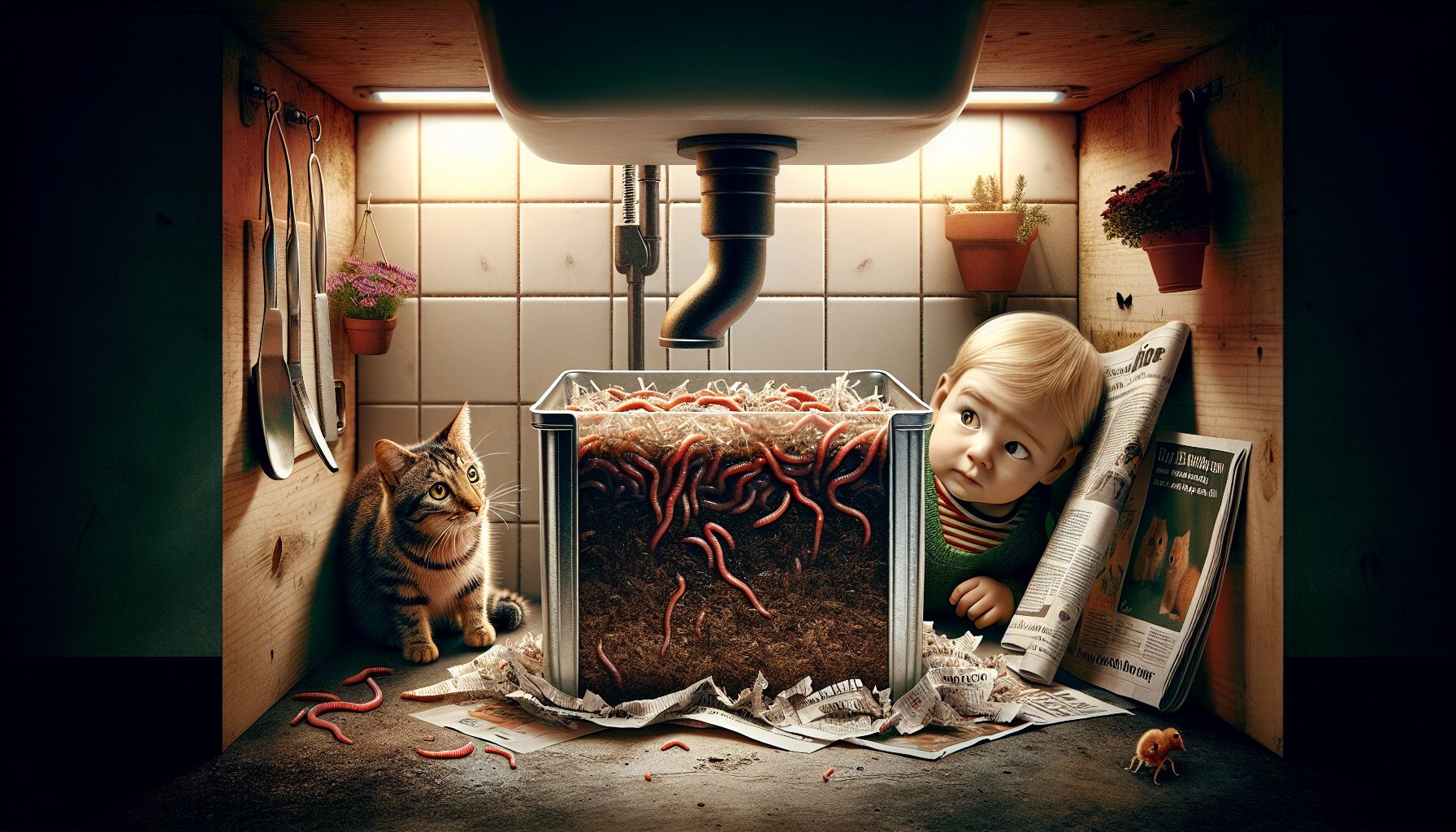 Small city balconies, shared rooftops, and tight back patios can feel more like chessboards than gardens. Every square foot matters — and when you’re trying to turn food scraps into fertile soil, the challenge gets real fast. The space constraints of urban homes often make composting feel like a luxury, not a basic human craft. But here’s the rub: if we’re serious about waste management and urban sustainability, rethinking how we approach composting isn’t optional. It’s essential.
Small city balconies, shared rooftops, and tight back patios can feel more like chessboards than gardens. Every square foot matters — and when you’re trying to turn food scraps into fertile soil, the challenge gets real fast. The space constraints of urban homes often make composting feel like a luxury, not a basic human craft. But here’s the rub: if we’re serious about waste management and urban sustainability, rethinking how we approach composting isn’t optional. It’s essential.
Now, space — or the lack of it — isn’t just a matter of physical dimensions. It’s about energy, intention, and rhythm. Composting isn’t simply tossing banana peels into a bin; it’s an invitation to return food to the earth with care. The question becomes: how do you maintain that ritual in a 700-square-foot apartment with a toddler, a cat, and no outdoor access?
One way is through smart container systems. Some folks find success with bokashi buckets, which ferment food waste rather than decompose it traditionally. They’re compact, low-odor when maintained right, and tuck easily under a sink or in a closet. Worm bins — or vermicomposting systems — are another solid option indoors. Red wigglers can take down a surprising amount of scraps, provided they’re not overfed or put in bad moods with citrus or onions. A tight lid and bedding material like shredded newspaper help keep smells minimal, and the bins themselves can be disguised with a piece of cloth or wood slab if aesthetics matter in your space.
That said, few things sabotage a composting effort faster than odor. And let’s just say — if it smells like a dumpster, something’s gone sideways. Compost should smell earthy, maybe sweet, like fall leaves and rain. Not like rot. Breathing room is key here. Whether your bin is on a windowsill or tucked beside your recycling, you need airflow. Good carbon-to-nitrogen balance matters too: think dry browns (like cardboard or straw) to anchor the wet greens (like veggie scraps). It’s chemistry, but also intuition — learned by tuning into the rhythm of decomposition.
“Science without heart is ignorance in motion.” — Ivan Illich
If the pile’s too wet or lacking oxygen, odor creeps in, as anaerobic bacteria take the wheel. Those are the ones responsible for the vinegary or sulfur-type funk. You can fix that by fluffing the pile, adding more dry material, or just pulling back on how much food you’re adding. It’s a living system — moody some days, forgiving others — but always responsive to attention.
Let’s be honest: urban composting isn’t always cute. Flies might show up if you get careless. Your roommate might not be thrilled about the “weird jar of goo” under the sink. But there’s something steadier underneath it all — a kind of quiet reverence. Every peel and stem you compost means less methane in a landfill. Less waste. More soil.
Some cities offer curbside compost pickup for apartment dwellers, or drop-off sites at farmers’ markets. In those setups, you don’t even need a home system. You just collect food waste in a lidded pail, then deliver it once or twice a week. Neighborhood-level compost co-ops are emerging too — shared bins in community gardens or rooftops, sometimes powered by volunteers. It’s a patchwork of solutions, but all of it feeds the same goal.
“Live simply so others can simply live.” — Mahatma Gandhi
And isn’t that the deeper point? Composting in small urban spaces isn’t just about logistics. It’s about relationship — to waste, to food, to land we might not even see beneath the sidewalk. It’s about participating, even imperfectly, in a natural cycle that doesn’t stop because we live four stories up.
There’s no one-size-fits-all fix here. But if you’ve got the will — and maybe a little countertop real estate — there’s always a way to go deeper than just throwing things “away.” Because really, there is no away.
This isn’t just waste management. It’s quiet rebellion. Soil-making in the cracks. And it starts with something as small as a peel.
Managing pests and contamination
Let’s get real about what trips people up after they start composting in a city — the moment when fruit flies launch a coup or mold shows up like an uninvited roommate. Managing pests and contamination in cramped urban quarters isn’t just a minor inconvenience. It’s often the make-or-break moment for someone trying to live more consciously. There’s no surer way to dampen enthusiasm than realizing your banana peel bin has become a bug hotel.
But don’t panic. Composting, at its core, is an ancient practice refined through attention and patience. When you think more like a steward than a scrambler, some of these common issues start to feel less like problems, more like guideposts. Nature always communicates — sometimes through gnats, sometimes through a strange smell. Either way, it’s giving feedback.
Let me explain.
Pests show up when balance falls off. If you’re dealing with fruit flies, it’s almost always a sign your system’s too wet, too exposed, or both. Scraps sitting on top of the pile act like neon signs shouting “buffet” to neighborhood bugs. The trick? First, *always* bury new food scraps under at least an inch of dry carbon material — shredded cardboard, sawdust, or crumpled brown paper work just fine. This practice alone cuts down on both odor and fly attraction by more than half. Second, if you’re using a worm bin or bokashi system, make sure the lid seals properly. Not plastic-wrap tight — they still need air. But sealed enough to interrupt an insect invasion.
If ants show up? They’re chasing sugar. Try adjusting what you put in — pull back on citrus rinds or overly sweet residue. And place the bin on legs or in a shallow tray of water — a good mechanical barrier against their entry.
Now, contamination — that’s the shadow side few people talk about. In a small urban home, it can sneak in when well-meaning roommates toss in things like cheese, oil-soaked pizza crust, or worse — bioplastics labeled “compostable” that don’t break down without industrial heat. In closed systems like bokashi, these items are tolerated, but they still carry a risk: improper fermentation may lead to mold, which ruins the microbial ecology and creates — well, a lot of slime and shaking heads.
If you’re working with a more traditional aerobic pile, dairy and meat are a no-go. They’ll rot fast, smell worse, and attract rodents even in rooftop setups you thought were squirrel-proof. Labeling your compost bin isn’t overkill — it’s a boundary. Composting is the kind of practice that benefits from clarity and rhythm. You want to train your household or your co-living group the same way you’d train a garden: repetition, gentle correction, and clear parameters.
“Clarity is kindness.” — Brené Brown
No compost system is set-it-and-forget-it. It’s maintenance work, like brushing your teeth or tending a fire. Mold popping up on the surface? Usually caused by poor ventilation or stacking too many moist layers. Flipping or stirring the contents once a week can oxygenate the pile and reset that microbial dance. If your mix is too slimy, add dry leaves or coconut coir (an urban composter’s secret weapon — lightweight, absorbent, and easy to store). On the flip side, if the pile feels like croutons, it’s probably too dry to decompose effectively. Add a splash of water and balance it with fresh greens.
There are some helpful tools, too, for keeping contamination in check:
- Compost thermometers — helpful for checking internal pile temps if you’re using a community bin or outdoor hot compost setup. Pathogens die at consistent high temps.
- Drain trays with biofilters — for bokashi systems; these keep leachate manageable and reduce anaerobic smells.
- Mesh screen layers — think fine netting sandwiched inside the lid to keep flies from entering, while still allowing airflow.
For more public or shared compost setups, labeling and signage become non-negotiable. Put up a simple guide (with pictures — fewer words, more clarity) that shows what’s welcomed and what’s not. Organizations like the Institute for Local Self-Reliance (ilsr.org) offer printables and region-specific advice for community compost systems.
Contamination also comes in through packaging. A lot of people buy “biodegradable” compost bags thinking they break down easily indoors — but many don’t, especially at small scales. Look for products that are ASTM-D6400 certified *and* tested in home compost conditions. If in doubt, skip the bags altogether and rinse your bins manually. It’s ten minutes of water and vinegar a week — time well spent for the health of your soil-maker setup.
There’s also a spiritual undercurrent here we can’t ignore. In a way, pests and contamination are just physical expressions of unchecked inputs — taking more in than we can process effectively. Composting systems need what we need: balance, breath, and rhythm. The moment things get chaotic — too much wet, too much rot, too much “just toss it in” — the integrity slips. But like us, the system can heal. One turn, one adjustment, one deeper listening at a time.
Rats, though? That’s a whole different level. If they’re around, pause your system and address the housing. Use a closed bin lined with hardware cloth (not chicken wire — rats chew right through that). In tight communities, rat sightings can reflect broader sanitation issues. So composting becomes not just a personal act, but a tether to communal stewardship and urban sustainability. Because when we let waste fester, we all carry the cost — and when we treat waste as life in process, the whole system benefits.
“The land is our altar, even if paved. Every act of respect renews it.” — Unknown grower, West Oakland
So yes, things can go sideways. Mold, bugs, smells that send your partner backing slowly out of the kitchen. But those moments are invitations — to become more alert, more clean, more tuned to the cues of decay and renewal. In small city spaces, managing this well is the difference between breakdown and breakthrough. And it builds a kind of quiet confidence, the inner “I can handle this” energy that seeps into other areas of life, too.
If the compost isn’t breaking down, fix the balance. If the flies show up, ask what opened the gate. Keep listening. Because the solution is rarely somewhere *out there* — it’s already right inside the bin.
Creative solutions for urban composting
 Sometimes you need to bend the rules to restore the rhythm.
Sometimes you need to bend the rules to restore the rhythm.
When composting in tight city quarters starts to feel like wrestling with logistics and roommates and raccoons (real or metaphorical), it’s a good sign you’ve outgrown the standard script. That’s where creative solutions come in — not just clever, but conscious. Composting in small spaces isn’t a one-size system. It’s a contact sport between design, intuition, and what your building manager will tolerate.
Start by asking, “What’s already working in my space?” Sometimes answers hide in the margins — an unused fire escape, a rarely opened closet, even an old rice cooker you didn’t think mattered. Urban composting is like jazz: what you’re improvising depends on where the beat lands.
Let’s walk through some grounded yet off-center ways people are composting creatively — with real-world applications for those willing to try.
1. Countertop fermentation systems
We talked bokashi earlier, but it’s worth revisiting because its flexibility is underrated. This method ferments, rather than decomposes, food waste using inoculated bran. What that means practically: no rot smells, no bugs, and no need for outdoor curing until you’re ready. Once full, you either:
- Bury the fermented waste in pots or planters to finish breaking down (a sneaky balcony solution)
- Drop it off at a local community compost hub if you don’t have soil access
If the idea of fermenting Brussels sprouts under your sink feels suspect, fair. But the results speak clearly. Bokashi buckets, like those from the brand SCD Probiotics or DIY versions with airtight lids and a spigot, give even the busiest apartment-dweller a fighting chance.
“In the beginner’s mind there are many possibilities; in the expert’s mind there are few.” — Shunryu Suzuki
That’s the thing: stay open to solutions that seem odd at first. This isn’t about tradition — it’s about fit.
2. Modular worm towers in vertical spaces
Lack of horizontal real estate is what stops most folks from composting. But what if you built up instead of out?
Modular worm towers — stackable trays that rotate or interlock — let you layer food waste and bedding in digestible stages. Brands like Hungry Bin or Subpod Mini make sleek, manageable systems that work on fire escapes, windowsills, or balconies. As the worms finish one tray, you add another above, and gravity handles the rest.
Some people install these near herbs or edible planters to streamline their food cycle — harvest, eat, return. That kind of closed-loop design supports not just waste management but urban sustainability you can feel between your fingers.
If you can’t find a pre-made vertical unit, a series of 5-gallon buckets drilled for airflow can do the job. Think Lego blocks for soil lovers.
3. Sharing systems in co-housing and apartment complexes
This one’s more social, but equally practical. Talk to your upstairs neighbor who’s always tending basil on the landing. See if others in your building are compost-curious. All it takes is one safe, agreed-upon bin — tucked beneath a stairwell or placed in the courtyard — to start a micro co-op.
Place a weekly rotation: one person monitors moisture, someone else drops at the farmers’ market, another keeps the bin tidy. Use an app like ShareWaste to connect with nearby compost hosts — real humans willing to receive your scraps in their bins. It’s like digital bartering for your broccoli butts.
This model expands what “a compost system” means — from personal duty to shared ritual. It’s the quiet heartbeat of regenerative living in cities. You see a banana peel differently when it’s headed to a patch of rooftop kale grown by someone you drink coffee with.
4. Clay pots and ancient rhythms
If you want hyperlocal, low-tech, and surprisingly elegant: look at terracotta composting. This technique — common in India’s urban homes — uses stacking clay pots with holes for airflow and slow drainage.
They’re beautiful, discrete, and perfect for the slower, aerobic decay of kitchen waste paired with dry carbon (like coconut husk or newspaper). You don’t overfeed these. You just keep them balanced and let time do what time does.
Modern versions from Daily Dump or DIY sets with plant-saucers as lids bring old-world sensibility into urban kitchens. They’re humble. But they work.
And maybe that’s the deeper message. We don’t need dazzling gadgets. We need systems that cradle our habits, not fight them. When your compost setup fits how you actually live — not how you think you should — consistency flows, and habits harden into instinct.
5. Community drop-offs and soil return programs
Say none of the above works for you. No space, no neighbors you trust, overwhelmed by the whole endeavor. You’re not failing. You’re transitioning.
Many cities now offer green waste pickup or partnered drop-offs through farmers’ markets, botanical gardens, or zero-waste collectives. You collect your scraps in a sealed bin or freezer bag and schedule a weekly run. Some even offer “compost credits” — finished soil you can return to your potted plants or donate to a garden.
Check out:
- Institute for Local Self-Reliance — for compost policy and community model info
- MakeSoil.org — crowd-sourced soil hubs searchable by zip code
These systems aren’t just a stopgap. They are composting by proxy — still part of waste reduction, still feeding the urban soil web.
—
Some folks treat composting like a hard science — ratios, temperatures, inputs, outputs. And that’s valid. But there’s also art and feeling in this process. Not every banana peel lands exactly in balance. Life doesn’t either. It’s the rhythm of paying attention that holds it all together.
Composting in urban spaces reveals the fuller picture of waste management. It’s about decentralizing responsibility. Listening to the micro instead of just the macro. Letting scraps feed something, not just disappear.
Too many of us were taught to be disconnected from the mess — from decomposition, from spoilage, from death and rebirth. But in a clay pot filled with orange peels, something sacred returns. The cycle reclaims its shape. And maybe — without fanfare — so do we.
 DS Haven In Light Of Things
DS Haven In Light Of Things






